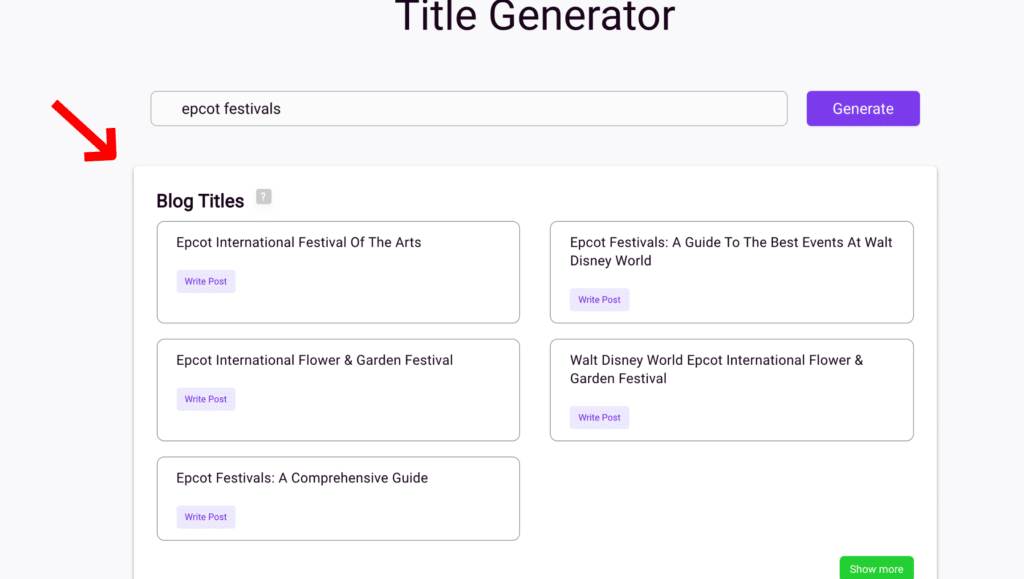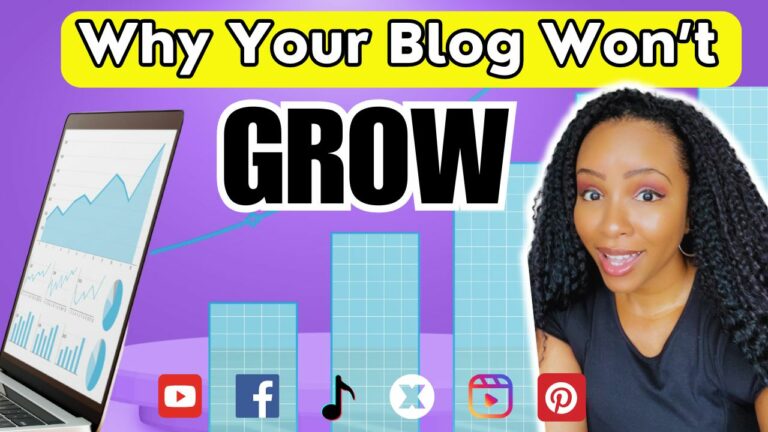Is Blogging Worth It in 2024: How to Master the Art of Blogging?

Just starting a blog? Have a blog and ready to give it up? Do you want to know how to master the art of blogging? Or are you trying to figure out if blogging is worth it today?
Don’t kill the blog just yet.
Let’s look at the bright side and how to turn blogging into a career. Here are some fun facts as to why you should put content at the top of your SEO building list.
Now see how you can master the art of blogging TODAY!!!
The Benefits of Blogging Today
Bluelist.co created an amazing list of facts about driving website traffic through blogging. These statistics are incredible!
Here are just a few of the top blogging statistics to help you understand the importance it has to help you increase website traffic:
- 409 million readers view more than 22.2 billion blog posts overall each month.
- Companies who blog receive 97% more links to their website.
- 66% of B2B marketers who blog generate more leads than those who don’t.
- US bloggers are projected to have a readership of 31.7 million by 2020.
- B2B marketers who use blogs receive 67% more leads compared to those who don’t.
Convinced yet? So are we.
I’ve already covered the benefits of blogging and as you’ve learned, there are quite a few. We are going to learn how to build and sustain website traffic through content.
Let’s jump into this ultimate blogging guide.
Master The Art of Blogging: Making Your Website Optimized for Search Engines
You realize that you have about three seconds to impress website visitors, right? Just three little seconds to impress, engage, and interest. No pressure.

Besides design and development, here are the top ways you can optimize your website for search. This will help your blog to build and sustain traffic, trust us. I have the ultimate blogging guide, after all.
1. Target Long-Tail Keywords
Google and other search engines love their keywords. When optimizing your website to build and sustain traffic, be sure to include your long-tail keywords. Yoast agrees.

Long-tail keywords increase your visibility
Include both primary and secondary keywords as much as you can across your landing pages.
Also, including long-tail keywords on your blog page can seriously increase your reach due to the unique search-ability.
2. Enable Lead Capture Subscriptions
What we’re really trying to do here is build an email database.
Don’t forget your objective when you’re writing your blog. There should be two ways you can capture emails when you’re trying to build traffic to your website.

We wouldn’t be helping you master the art of blogging if we didn’t recommend that!
Include a reason for a visitor to submit their email in the copy of your content. Also, have a few different areas on your website where the visitor can subscribe to your blog, get a free eBook or get a monthly newsletter.

Don’t forget about adding scroll boxes, exit-intent pop-ups, and website banners to obtain email addresses too. A great tool for lead capture is Sumo, check it out!
3. Have Landing Page Links
If you’re expecting visitors to find your blog, you should probably include a landing page to it.

It’s up to you to build links to your blog in unique ways. This blogging guide is about helping you get more visitors to your blog and how to turn blogging into a career.
4. Be a Valuable Resource
The whole reason you created a blog is to be a valuable resource to your visitors. That includes providing them with valuable content, free educational marketing and a reason to come back.

The important lesson you want your visitors to learn about you is that you are providing them value. You aren’t there to sell your product or service until you’ve earned their trust.
Provide value > Selling yourself
Providing your visitor with good content, educational resources like eBooks, webinars, and guides are all great reasons to get returning visitors, according to the Work at Home Woman.
This is the ultimate blogging guide after all and we hope it has been a valuable resource to you.
5. Use Trackbacks
What’s a trackback? Yaro Starak said it best. “A trackback is a form of “blog conversation” that links two or more relevant blog entries together.”

This is a two-step process of both partnering with other bloggers and creating administrative settings on your blog. Each blog is different to enable permissions for trackbacks, however, it should be simple.
Do some research to see if it’s for you.
Master the Art of Blogging: How to Format Your Blog Posts the Right Way…
If you’re going to write a blog post, you should make it beautiful. Is there anything worse than an ugly blog?

We are going to cover the basics of content formatting in this blogging guide to sustaining traffic, so follow these important tips.
1. Write Powerful Headlines
Headlines are much like the cover of a book. They need to grab your attention and interest you enough to keep reading.

Just like everything else in marketing, the evolution of crafting good headlines changes often.
2. Use Shorter and Bolder Paragraphs
We live in a fast-paced world. Reading blogs most often boils down to skimming the article to find the best parts, do you agree?

The better you can break out your blog articles through shorter paragraphs, bolding the good parts and highlighting your links the more people will appreciate your content. I have highlighted that for you right here in this article for you!
We do hope it’s helpful.
3. Use Your Headers the Right Way
Along with breaking up the paragraphs, the headings in your blog need to be organized. If you have a series of headers that don’t make sense to the blog, it will not make sense to your audience either.

Headings are not just for titles and topics!
They are beneficial to your blog for structure, accessibility, and SEO. Check out our break down how to use headings along with the importance of them and some great examples.
PRO TIP: Don’t bold your headings. We know you are excited to blog, but the size along will carry the weight of the topic alone. #contentmarketing Share on X4. Know the Benefits of Both Long-Form and Short-Form Content
Every blogger knows this is the age-old question of content etiquette. Do you write shorter articles or longer? The answer is both!

Each industry is different and may require different strategies when blogging. Google has been known to like slightly longer articles that carry a lot of information.
A few experts like Neil Patel and HubSpot have stated that the more you write, the more you can extend time on page for your website analytics.
In this blogging guide, I want you to choose what is best for you.
There is a sweet spot that you should try to adhere to when writing content. We try to stay between 1500-2500 words here at Bramework.
5. Create Calls-to-Action (CTA)
Writing content isn’t about just putting words on paper anymore. We aren’t writing novels here! We want to engage our audience with fun interaction. So, how do we do that?

There are a few ways you can interest your reader with different calls to action. You can add click-to-tweets like this…
{Click to Tweet} “Wow this ultimate blogging guide just taught me SO much about content marketing! I feel totally ready to get writing now, thanks @Bramework! You guys rock!”
Whatever the call to action is, make it personalized
You can also break up your content with free resources. Here are a few examples: offer a free eBook on your expertise, extend a sign up to a webinar that teaches them something of value or invite them to a fun podcast.
Here are some of the most powerful words to put together some fun ways to include calls to action in your content.
6. Add Images to Tell a Story
In this blogging guide, you’ll see that we have several fun images throughout our article. These images weren’t just picked at random and thrown in to make it pretty. Well, they do make it pretty but they have an ulterior purpose.

When inserting images into your content, be sure to go the extra steps to enable them to be searchable and clickable.
Edit the image to have a title and Alt Text which may be one of your keywords or whatever the image is explaining. This allows your image to be found on the search engines, even if your article isn’t!

The experts at Moz break down the rules of Alt Text and how to make them work for your content.
Also, hyperlink your image to the source, the relevant keyword or another internal link for your domain – whichever applies there.
Just be sure to link it up because you have no idea how many people click on images! Hint: it’s a lot more than you think.
7. Add Tags and Categories
Don’t forget about the details of writing an article! Knowing how to correctly set up the administrative settings is equally important to writing the article itself.

Every CSS is different, however, they all have the option to set tags and categories for the article. Tagging is another way for search engines to index your article.
The tags and categories should be the keywords you would like the article to rank for. The difference between the two is that categories are broad and tags are specific.
Blogging Basics 101 covers the importance of tags and categories if you would like additional information.
8. Enable Comments
If you want to be really brave, enable comments on your blog to see what people really think!
Beware, when you enable comments you will invite both positive and negative responses.
The benefit of enabling comments is that you have yet another reason to engage with your audience.
Also, if there is negative feedback, you can respond and alter the article accordingly if you choose. Often times, you will find that you will get positive feedback that starts great relationships.
Mastering the Art of Blogging: Use Internal and External Link Mentions
At Bramework, we’re passionate about blogging. We, myself especially, love to write articles that help people learn about the power of content.

Part of that passion lies in the partnerships you can build by simply linking out correctly.
Find passion in partnerships
Here are a few basic guidelines to internal and external link mentions that you should include in your content.
1. ALWAYS Include Internal Links
One of the many benefits of writing your own blog means you can brag a bit about your expertise. Why not?
It’s okay (and encouraged) to include 3-5 internal links to your content or service. Be sure to link to the keywords you’re trying to rank for and space them out.

Starting an article off with all the amazing things that you do and linking to nine different services you offer may not be the best strategy.
Each link that you are placing about yourself or your service should be included to share value to your reader, not to pressure them to buy.
2. Use Appropriate Link Mentions
When you’re linking out to other companies or services, there are a few rules.
The first rule of appropriate link mentions is you don’t talk about link mentions. Just kidding. The first rule is to never link out to your competitor or a competitive article!
That doesn’t make sense, does it?
The second rule is you want to link out to experts in the industry that can also offer value to your reader. Most of these have a higher domain authority, which would be helpful to your article if they chose to share it.

If you are not sure about domain authority, be sure to do your homework here. Check out these simple steps to increasing your DA by SEOPressor.
Earning backlinks should be high on your list of content marketing tactics, and linking to higher domain authority websites is a great way to do so.
3. Know How to Request Backlinks the RIGHT Way
This is a bold strategy and only recommended when you have been blogging for a while.
The backlink strategy is for when you feel established in your content marketing strategy, have raised your domain authority a bit and feel you have some clout in the market.

If you are crushing it, you can manually reach out to companies that are blogging about relevant topics and ask for a link to be added to their article about you.
If you are doing it right, you should offer them a link to one of your articles first which shows good faith.
Requesting links is a long process and should be used with a soft touch, a positive attitude, and a persistent manner.
Basically, you have to give some to get some when it comes to requesting links.
4. Partner with Influencers
This art of blogging guide is about to drop the biggest content marketing strategy right in your lap! Influencer outreach should be a big part of your blog.

Here’s the quick and easy way to implement an influencer outreach strategy for your content.
Write an article, cite 15-20 high DA websites, obtain their contact details and email them to let them know they were featured. Include a positive comment or thank them for their expertise and encourage them to share it nonchalantly.
Using this formula will help your content get shared by bigger companies, it will help you build relationships for partnership opportunities and it will show you’re passionate about other people rather than just yourself.
Mastering the Art of Blogging: Be a Social Butterfly Blogger
A big part of content marketing is the social aspect. I think we can all agree that the best part of writing a blog post is when it’s all finished and you get to share it with the world.
Here are some ways you can share your content and the best tactics to do so.
1. Share Yours and Share Others
Sharing is caring, we’ve established this. It’s important to share your content creatively and consistently. You can share your articles in different ways across the different social media platforms.

Also, you can re-share other people that have shared your content and it will seem fresh and new!
Just don’t forget to share other experts, friends, and partners along with your own content. It’s important for Google and for your audience to see that you value others just as much as yourself.
2. Add Tag Citations and Hashtags
When you share your content, be sure to tag the websites that you cited or referenced. This is a great way to show that you’re excited to feature them.
Here’s an example: “New blog post is out at Bramework! Learn the ultimate blogging guide to build and sustain traffic featuring experts like Moz, Yoast and Shane Barker!” In this post, you can include the tagging for each social platform if available for each citation.
Empower that hashtag!
Don’t be afraid to use hashtags in the post either! Don’t hashtag every word, just the relevant keywords you would like to be ranked for.
PRO TIP: Don’t over hashtag! Learn the rules of hashtagging from the experts at SumAll.
Mastering the Art of Blogging: Add Webinars, Podcasts & Event Building
A big part of your content should be bridging the gap between what you offer and what value you can give to your visitors.
We mentioned calls to action earlier in this ultimate blogging guide, here are some great examples of what you can extend to your audience.
- Invitations for webinars
- Featured guests on podcasts
- Interview industry thought leaders
- Share a public speaking event
Be sure to dedicate time to each of these as they are a bit tedious! Executing a successful webinar may take months of preparation.
Featuring guests on podcasts takes time to filter through quality partnerships. Make time for marketing and it will benefit you greatly.
Mastering the Art of Blogging: Encourage Affiliate Marketing
One of the underdogs of content marketing is the use of affiliates. There are so many companies that are not taking advantage of affiliate marketing!
When your content is up and running, begin an affiliate marketing program immediately.
You can offer commission-based referrals, percentages of sales or services to each affiliate that brings in a customer. All of this can be done right through your blog.
Getting creative with affiliate marketing is key.
You want to build a landing page for affiliates with an application, information about the program and a place to go for a payment. Offer banner ads and creative graphics so they can promote your service with everything they need.
Mastering the Art of Blogging: Get Guest Posting
What is guest posting and what are the rules?
The first rule is, you should be doing it! Guest posting is when you offer to write an article for another person and have them host it on their website.

The benefits of guest posting are huge!
It’s a way to earn backlinks from additional sources, it’s an avenue for relationship building and it’s a great way to show off your talent outside of your own website.
Be overly prepared when guest posting
You can offer guest posts on other sites and invite people to post an article on your website as well. It’s a big job to wrangle guest posting successfully. QuickSprout has come up with a few rules you should follow for guest posting.
I suggest you do some research before diving in.
Mastering the Art of Blogging: Connect to the Online Community
Content doesn’t need to just be shared on social media. There are thousands of different online communities where you can get your blog involved.
Check out this list of avenues you can take to get your blog involved with the online community:
- Blogger Lists (Check out this massive list at Mashable of online communities for bloggers.)
- Author Communities
- Content Marketing Directories
- Quora
- Medium
Mastering the Art of Blogging: Create AMAZING Email Content!
As we are writing, are we building our email database? Of course, we are!
We have successfully created calls to action to obtain emails along with amazing content.
Now you have the power to wow your readers with a respectable e-newsletter. Time to get your tools out and create the most interesting email marketing campaign you can think of.
Blogs give you a reason to email your audience!
This is a big job, but we’re confident you can do it. Check out this rad article by Venngage about engaging email newsletter templates for some inspiration.
Mastering the Art of Blogging: Be Different, Be Fun, Be Personal
Last, but definitely not least, when writing your blog – please be yourself. The content world is saturated with articles that are stuffy, tight and just plain boring.

Be yourself! Don’t be afraid to be bold, your audience will learn that you are human and they will love you for it.
Be a unique voice in an otherwise mundane world
Here are some fun ways that the team here at Bramework add a little pizzazz to their content:
- Tell stories
- Include your team
- Use videos, GIFs, memes + more
- Be quotable
- Ask questions
Other than giving your audience value, give them personality!
Is Blogging Worth it Today?
Absolutely! It’s incredible way to build a business of your own that not only pushes you to get outside of your comfort zone, it also allows you to create a sense of freedom in your life like never before!

I hope this guide to mastering the art of blogging to build and sustain traffic has been insightful and helpful. As you know, at Bramework, we want you to blog better!
What ways have you learned to optimize your blog to drive traffic? We want to hear from you.
What do we do, you ask?
We help your content get more click-throughs, more subscribers, and more engagement in a fraction of the time it takes you to create a blog post.
Our platform uses an AI Writing Assistant to increase your search ranking and get you seen by the right audience.
We basically create blog magic.
Reach out to us if you want to try it out!
Happy blogging friends!
Bramework
UP NEXT: How to Create an EPCI Blog Post Title in Less than One Minute!
Image credit: Unsplash
(Original Article Date: January 1, 2020/Updated by Editor on December 6, 2022)





Caylin these are great tips. Being a resource sticks out to me because resources become successful. Be generous and patient. Allow that combo to pull you along.
Ryan